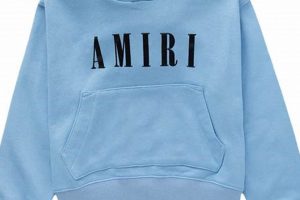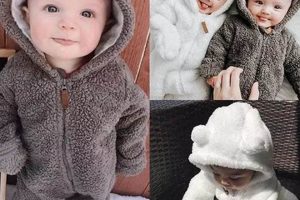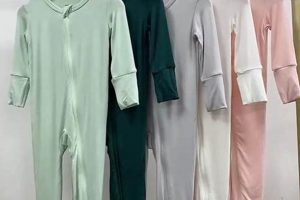The most effective method for preserving infant apparel involves careful consideration of material, environment, and accessibility. This encompasses techniques like vacuum sealing out-of-season items, organizing by size, and utilizing acid-free storage containers. For instance, delicate garments may benefit from being individually wrapped in archival tissue paper before placement in a storage box.
Proper preservation of these items offers numerous advantages, including maintaining the integrity of the fabrics, preventing damage from pests or environmental factors, and facilitating their use for subsequent children or future generations. Historically, preservation methods relied on natural repellents and temperature-controlled environments; modern techniques leverage technology and specialized materials for enhanced protection.
Effective strategies will address the cleaning and preparation of clothing, selecting appropriate storage locations and containers, and establishing a system for easy retrieval and future use. The following sections detail these facets to ensure optimal preservation and management of infant garments.
Essential Preservation Strategies for Infant Apparel
The following guidelines outline effective practices for maintaining infant garments in optimal condition, ensuring their longevity and potential future use.
Tip 1: Pre-Storage Preparation: Thoroughly launder all items before storing. Stains and residues can attract pests and degrade fabric over time. Utilize a gentle, fragrance-free detergent suitable for delicate materials.
Tip 2: Material Assessment and Sorting: Separate clothing by fabric type. Natural fibers, such as cotton and wool, require different storage conditions than synthetics. This facilitates targeted preservation efforts.
Tip 3: Container Selection: Opt for airtight containers to protect garments from dust, moisture, and pests. Acid-free cardboard boxes or plastic bins are recommended. Avoid storing clothing in plastic bags, as they can trap moisture and promote mildew growth.
Tip 4: Temperature and Humidity Control: Store clothing in a cool, dry location. Avoid attics, basements, and garages, where temperature fluctuations and humidity levels are often extreme. Ideal conditions minimize the risk of fabric damage.
Tip 5: Organization and Labeling: Organize clothing by size and type for easy retrieval. Clearly label all containers with detailed descriptions of the contents. This prevents unnecessary handling and disruption of stored items.
Tip 6: Moth Protection: For wool or other susceptible fabrics, consider using natural moth repellents such as cedar chips or lavender sachets. Avoid mothballs, as they contain chemicals that can be harmful to infants and damage clothing.
Tip 7: Regular Inspection: Periodically inspect stored clothing for signs of damage, pests, or discoloration. Address any issues promptly to prevent further deterioration.
Adhering to these practices ensures the long-term preservation of infant apparel, maximizing its potential for reuse or sentimental value. Prioritizing proper cleaning, appropriate storage, and environmental control are essential components of effective garment maintenance.
The subsequent sections will address the specific types of storage containers, optimal storage locations, and methods for preparing clothes to maximize longevity.
1. Cleaning before storing
The practice of cleaning garments prior to storage is integral to the preservation of infant apparel. Residual dirt, stains, and body oils can degrade fabric over time, attract pests, and foster the growth of mildew, compromising the long-term usability of the stored items. As such, pre-storage cleaning is a fundamental step in effective garment maintenance.
- Stain Prevention
Unremoved stains are not merely cosmetic issues; they can oxidize and permanently damage fabric fibers. Food stains, in particular, can attract insects and rodents, creating a breeding ground within stored clothing. Cleaning removes these potential threats, preserving the material’s integrity.
- Pest Deterrence
Many pests, such as moths and carpet beetles, are attracted to organic residues found in unwashed clothing. These pests can cause significant damage, creating holes and weakening fibers. Thorough cleaning eliminates the food source, reducing the likelihood of infestation.
- Mildew Control
Moisture trapped in uncleaned clothing can lead to mildew growth, especially in humid environments. Mildew not only creates unpleasant odors but also weakens fabric and causes discoloration. Washing and thoroughly drying items prior to storage minimizes this risk.
- Fiber Preservation
Body oils and sweat can break down fabric fibers over time, leading to yellowing and weakening. Cleaning removes these substances, maintaining the structural integrity of the clothing. This is particularly important for delicate fabrics or heirloom items.
Therefore, cleaning garments before storage serves as a proactive measure against potential damage from stains, pests, and mildew, thereby extending the lifespan of infant apparel. Failing to implement this practice undermines other preservation efforts, increasing the risk of material degradation and rendering stored items unusable. Prioritization of cleaning establishes a foundation for effective long-term garment preservation.
2. Airtight Containers Advised
The recommendation to utilize airtight containers for infant apparel storage is a cornerstone of optimal preservation techniques. The primary function of these containers is to establish a barrier against environmental elements that contribute to fabric degradation. Without such protection, stored clothing is vulnerable to moisture, dust, pests, and fluctuations in temperature and humidity. These external factors can lead to mildew growth, insect infestations, discoloration, and weakening of fabric fibers. The use of airtight containers mitigates these risks, creating a stable and protected environment for stored items. For example, placing delicate cotton baby clothes in a plastic bin with a tight seal shields them from dust and potential water damage during long-term storage in a basement.
The selection of appropriate airtight containers directly influences the efficacy of the preservation process. Opting for acid-free plastic or archival-quality cardboard boxes minimizes the risk of chemical reactions with the fabrics. The airtight seal prevents the ingress of airborne pollutants and pests, preserving the cleanliness and integrity of the stored items. Furthermore, the container’s design should facilitate easy stacking and labeling, allowing for efficient organization and retrieval. The absence of an airtight seal negates many of the benefits associated with careful cleaning and preparation, rendering the stored items susceptible to damage despite other preservation efforts. A real-world example would be placing clothes in a non-airtight cardboard box in an attic, leading to insect damage and discoloration over a period of months.
In conclusion, the strategic use of airtight containers forms an integral part of a comprehensive approach to preserving infant apparel. While other aspects such as pre-storage cleaning and climate control are important, the physical barrier provided by these containers is essential for protecting stored items from environmental damage. The selection of appropriate materials and proper sealing techniques are crucial for maximizing the preservation benefits and ensuring that the clothing remains in optimal condition for future use. Ignoring this key element significantly increases the risk of fabric degradation and diminishes the long-term value of stored infant garments.
3. Climate-controlled environment
Maintaining a stable and regulated climate constitutes a crucial element in effective infant apparel storage. Environmental conditions directly impact fabric integrity and the potential for degradation, rendering climate control a significant determinant of long-term preservation success.
- Humidity Regulation
Excessive humidity fosters mold and mildew growth, causing staining and fabric decay. Conversely, overly dry conditions can lead to fiber desiccation and brittleness. A controlled environment maintains a relative humidity level, typically between 45% and 55%, which inhibits microbial activity and preserves fabric suppleness. An example is the use of a dehumidifier in a basement storage area to prevent moisture accumulation on stored baby clothes.
- Temperature Stability
Fluctuations in temperature accelerate fabric degradation processes. Extreme heat can melt synthetic fibers and cause discoloration, while freezing temperatures can damage delicate materials. A consistent temperature, ideally between 60F and 70F (15C and 21C), minimizes stress on fabric fibers and slows down chemical reactions that lead to deterioration. Storing baby clothes in an attic with drastic temperature shifts is inadvisable without proper insulation and climate control.
- Air Quality Management
Airborne pollutants, such as dust, smoke, and volatile organic compounds (VOCs), can contaminate stored clothing and contribute to discoloration and odor absorption. A climate-controlled environment incorporates air filtration systems that remove particulate matter and gaseous contaminants, safeguarding the cleanliness and freshness of stored items. Using an air purifier in a storage room can significantly reduce dust accumulation on stored fabrics.
- Light Exposure Mitigation
Prolonged exposure to light, especially ultraviolet (UV) radiation, causes fading and weakening of fabric fibers. A climate-controlled environment minimizes light exposure through the use of opaque containers and window coverings, protecting stored clothing from the harmful effects of UV radiation. Storing baby clothes in a closet rather than in direct sunlight helps to preserve their color and structural integrity.
These facets demonstrate that a climate-controlled environment is not merely a desirable feature but a fundamental requirement for optimal preservation of infant apparel. The regulation of humidity, temperature, air quality, and light exposure creates a stable and protective environment that mitigates the risks of fabric degradation, ensuring that stored items remain in optimal condition for future use. Neglecting climate control jeopardizes the efficacy of other preservation efforts and compromises the long-term value of stored garments.
4. Organization by size
The methodical arrangement of infant garments according to size constitutes a fundamental aspect of effective storage practices. This organizational approach directly impacts both the accessibility and preservation of stored items, contributing significantly to the overall effectiveness. Failure to categorize clothing by size results in disarray, making it difficult to locate specific items when needed and potentially leading to unnecessary handling, which can accelerate fabric wear and tear. For instance, mixing all sizes together requires extensive rummaging to find the desired garment, causing disturbance and increasing the risk of damage. In contrast, a system where newborn clothes are separated from 3-6 month sizes streamlines retrieval and minimizes handling.
The implementation of size-based organization offers several practical benefits. It allows for accurate inventory management, facilitating the identification of gaps in a child’s wardrobe as they grow. This enables timely procurement of appropriately sized clothing, preventing situations where a child lacks essential garments. Furthermore, organizing by size assists in efficient rotation of seasonal clothing. As the seasons change, appropriately sized garments can be easily accessed and brought into active use, while out-of-season items are neatly stored, minimizing clutter and maximizing storage space. An example would be quickly locating the correct size winter coat when temperatures drop, without having to sift through clothes that are too small or too large.
Therefore, organization by size is not merely an aesthetic consideration but a crucial element that optimizes accessibility, facilitates efficient inventory management, and minimizes fabric damage. This structured approach streamlines the process of retrieving and storing infant garments, ultimately contributing to their preservation and ensuring their availability when needed. Neglecting this practice leads to inefficiency, potential damage, and increased effort in managing a child’s wardrobe, underscoring the practical significance of incorporating size-based organization into the overall clothing storage strategy.
5. Material appropriate storage
Infant apparel comprises a diverse range of materials, each exhibiting unique properties and requiring tailored preservation techniques. The selection of appropriate storage methods directly influences the longevity and condition of these garments. Implementing storage strategies without considering material composition risks accelerated degradation, rendering items unusable. Consequently, material appropriate storage constitutes an indispensable element of any strategy aiming to achieve the most effective preservation of infant garments. For example, storing delicate silk or wool items in the same manner as durable cotton fabrics can lead to irreversible damage, highlighting the imperative for a differentiated approach.
Material-specific considerations manifest in several practical applications. Natural fibers, such as cotton and linen, benefit from breathable storage solutions to prevent moisture accumulation and subsequent mildew growth. Conversely, synthetic fibers, such as polyester and nylon, are less susceptible to moisture but may be prone to static cling and should be stored in a manner that minimizes friction. Garments crafted from animal fibers, such as wool and cashmere, necessitate protection from moths through the use of natural repellents like cedar chips or lavender sachets. Furthermore, items with embellishments, such as buttons or embroidery, require storage methods that prevent snagging or damage to these delicate features. Choosing between a hanging garment bag for a delicate christening gown or a vacuum-sealed bag for out-of-season cotton onesies are prime examples of applying material-appropriate tactics.
In summary, the effective preservation of infant garments hinges on the implementation of material appropriate storage practices. Ignoring the unique characteristics of different fabric types jeopardizes the integrity of stored items and undermines overall preservation efforts. This understanding dictates that a comprehensive approach to clothing storage must encompass a nuanced assessment of material composition, guiding the selection of appropriate containers, storage locations, and preventative measures. By prioritizing material-specific considerations, the durability and usability of infant apparel can be significantly extended, maximizing their value for future use or sentimental preservation.
6. Regular Inspection crucial
The consistent monitoring of stored infant apparel represents a critical component of effective preservation strategies. Periodic assessment allows for the early detection of potential issues that could compromise garment integrity, thereby maximizing the lifespan and usability of stored items.
- Early Detection of Pest Infestation
Stored garments are susceptible to damage from moths, carpet beetles, and other pests. Regular inspection facilitates the prompt identification of infestations, enabling swift intervention before significant damage occurs. The discovery of moth larvae or webbing necessitates immediate action, such as vacuuming the storage area and employing appropriate pest control measures. This proactive approach minimizes fabric loss and preserves the overall condition of the clothing.
- Identification of Moisture Damage
Humidity and temperature fluctuations can lead to moisture accumulation within storage containers, fostering mold and mildew growth. Regular inspection enables the detection of dampness, discoloration, or musty odors, indicating potential moisture damage. Addressing these issues promptly, through improved ventilation or dehumidification, prevents irreversible fabric decay and safeguards the health of stored items. For instance, if inspecting stored clothes reveals water stains, the immediate response should be to identify and remedy the source of the leak to prevent further damage.
- Assessment of Fabric Degradation
Even under optimal storage conditions, fabrics can gradually degrade over time due to oxidation, light exposure, or chemical reactions. Regular inspection allows for the monitoring of fabric integrity, including the detection of fading, weakening, or embrittlement. Identifying these signs early enables informed decisions regarding the suitability of continued storage or the need for alternative preservation methods, such as archival storage or professional cleaning. Noticing yellowing on white fabrics can be a sign of oxidation, allowing for appropriate cleaning and storage adjustments.
- Verification of Storage Container Integrity
The effectiveness of airtight containers relies on maintaining a secure seal and preventing the ingress of contaminants. Regular inspection ensures that containers remain intact and free from cracks or damage. Identifying compromised containers allows for the prompt transfer of stored clothing to alternative receptacles, safeguarding items from exposure to environmental elements. The identification of a cracked storage bin necessitates the immediate transfer of its contents to a more secure vessel.
These facets underscore the importance of regular inspection as an integral element of effective infant apparel storage. Proactive monitoring enables timely intervention, minimizing the risk of damage from pests, moisture, fabric degradation, and compromised containers. This proactive approach ensures the long-term preservation of stored items, maximizing their value for future use or sentimental purposes. A storage regime that omits regular inspection jeopardizes the efficacy of other preservation efforts, significantly increasing the risk of garment damage and loss.
Frequently Asked Questions Regarding Infant Apparel Storage
This section addresses common inquiries regarding the most effective methods for preserving infant clothing, focusing on practices that ensure long-term garment integrity and usability.
Question 1: Is it necessary to wash baby clothes before storing them long-term?
Yes, laundering is essential. Residual stains, body oils, and odors attract pests and contribute to fabric degradation over time. Employ a gentle, fragrance-free detergent to minimize chemical residue.
Question 2: What type of storage container is recommended for infant apparel?
Airtight containers crafted from acid-free materials are preferred. These protect garments from moisture, pests, and environmental contaminants. Avoid plastic bags, as they can trap moisture and promote mildew growth.
Question 3: What is the ideal environment for storing infant clothing?
A cool, dry, and dark location is optimal. Attics, basements, and garages are often unsuitable due to temperature fluctuations and humidity levels. Aim for a stable environment with minimal exposure to light.
Question 4: How should garments be organized within storage containers?
Organizing by size and type is recommended. This facilitates easy retrieval and prevents unnecessary handling. Label containers clearly to identify contents without disturbing stored items.
Question 5: Are mothballs an acceptable method for protecting stored wool clothing?
Mothballs are not recommended due to their potential toxicity and odor. Instead, employ natural moth repellents such as cedar chips or lavender sachets. Ensure that these repellents are appropriately contained to prevent direct contact with fabrics.
Question 6: How frequently should stored infant clothing be inspected?
Periodic inspection, ideally every six months, is advisable. This allows for the early detection of pest infestations, moisture damage, or fabric degradation. Addressing any issues promptly minimizes potential long-term damage.
Proper storage of baby clothes is essential to maintain their quality and preserve them for future use or sentimental reasons.
The following section will detail a checklist of all things you need for storage.
best way to store baby clothes
The preceding exploration has elucidated the multifaceted nature of optimizing infant apparel storage. Effective strategies encompass thorough pre-storage cleaning, utilization of airtight containers, environmental control, organization by size, material-appropriate storage solutions, and consistent monitoring. Adherence to these principles mitigates the risk of damage from pests, moisture, and fabric degradation, thereby preserving the value and usability of stored items.
The implementation of these storage protocols represents a commitment to responsible resource management and the preservation of cherished possessions. Prioritizing proper storage techniques ensures that infant apparel remains in optimal condition, potentially extending its utility for subsequent generations or facilitating its contribution to charitable causes. The future utility or charitable contribution of such meticulously stored garments is entirely contingent upon adherence to these best practices.


![[Guide] Smart Grow With Me Baby Clothes Savings Tips Baby Care 101: Essential Tips for Happy, Healthy Babies [Guide] Smart Grow With Me Baby Clothes Savings Tips | Baby Care 101: Essential Tips for Happy, Healthy Babies](https://singlebabies.com/wp-content/uploads/2025/10/th-970-300x200.jpg)




